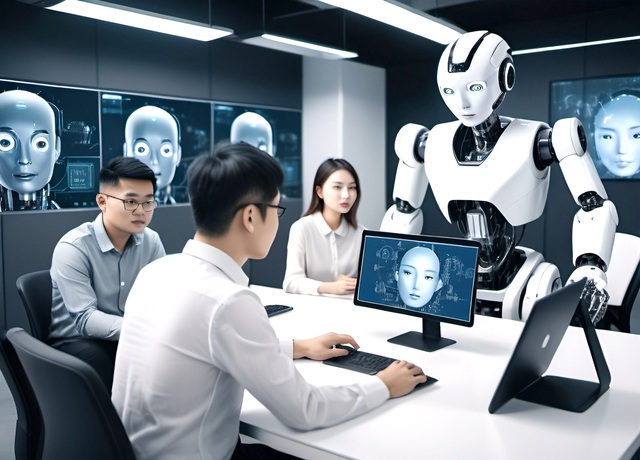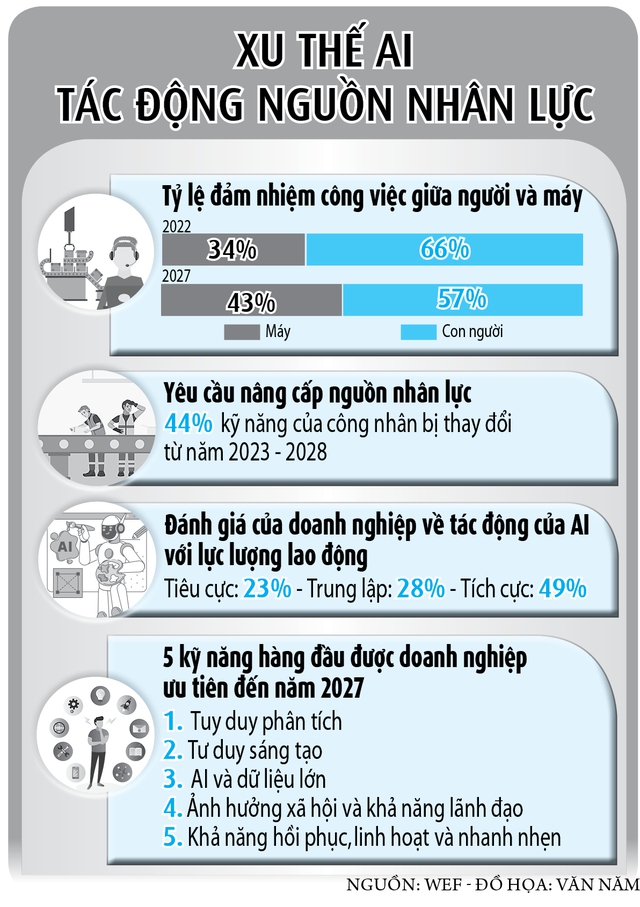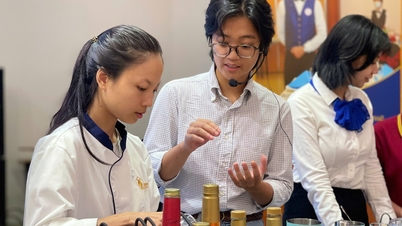Although it cannot replace humans, the explosion of artificial intelligence is forcing the workforce to adapt to keep pace with the trend.
Today, generative artificial intelligence (AI) is emerging as a tool to boost human productivity. The World Economic Forum (WEF) has identified enhanced productivity as a key driver of potential economic growth, with a strong correlation between the use of AI in the workplace and higher productivity.
We need to upgrade our workforce to meet the trends of artificial intelligence.
Photo: Pham Hung
Profound changes across all labor groups.
According to a report published on April 29 by the Centre for Progressive Governance Research (CIGI, Canada), the shift in workers began even before the latest developments in AI. For example, personal computers and then tablets have rendered the receptionist position almost obsolete in many places because customers can interact with customers themselves.
Artificial intelligence has a significant impact on labor market shifts.
Photo: Created by AI
According to Oxford Economics, robots could replace an additional 20 million jobs globally by 2030. Goldman Sachs also published a report estimating that AI could impact 300 million jobs globally due to automation. The report also states that in the US and Europe alone, two-thirds of jobs could be replaced by AI, and one-quarter could be replaced by AI.
According to CIGI, AI also creates a complex impact on the global workforce. For example, self-driving cars will not only eliminate the need for drivers but are also predicted to reduce accidents, potentially leading to a reduction in the number of police officers, medical personnel, and auto repair workers.
The advent of innovative AI has transformed the workplace landscape. While previous automation focused primarily on manual labor, innovative AI is impacting office jobs in areas previously unsuitable for automation, such as auditing and marketing.
There are unforeseen consequences associated with AI's increasing penetration into the workforce. For example, there is a widening wage gap between the highest-paid, highly skilled, "AI-powered" workers and the lowest-paid workers, which is making the workplace increasingly polarized.
Not the end of the world
Meanwhile, The Economist magazine published an article suggesting that we shouldn't be too pessimistic about the risks AI poses to the workforce. The article wittily stated that replacing "8 billion people" with robots is unrealistic, so there won't be a "doomsday" for human jobs. In fact, in the US alone, there's a shortage of over 500,000 manufacturing jobs, and that number rises to 800,000 in the F&B (food and beverage) sector.
The article cites the past, where workers in some places vandalized factories when automated machinery systems appeared. However, history also shows that with the increasing number of machines, such as robots in automobile factories, the workforce will transition to a different stage. According to the International Federation for Automation (IFR), even South Korean companies, currently the world's largest adopters of robots, employ 10 production workers for each industrial robot. In the US, China, Europe, and Japan, this number is 25-40 workers per robot. According to consultants at the Boston Consulting Group (BCG), in 2020, the world spent approximately $25 billion on industrial robots, but this represents less than 1% of global capital expenditure. Of course, to avoid doing the jobs that robots have replaced, workers must upgrade their skills to be able to operate robots.
In this regard, the Goldman Sachs report emphasizes that: "The historical shift of workers away from automation has been offset by the creation of new jobs, and the emergence of new professions following technological innovations accounts for a large portion of long-term job growth. The combination of significant labor cost savings, new job creation, and higher productivity for workers who do not lose their jobs increases the potential for a productivity boom, thereby driving significant economic growth." From this, Goldman Sachs concludes that AI may take away many jobs but will create many new ones.
But there is a structural change, requiring an upgrade.
In its latest report assessing global labor structure trends, the WEF cited a survey on the future of work, based on opinions from representatives of 803 companies employing a total of more than 11.3 million workers across 27 industry clusters and 45 economies worldwide.
The results predict that 42% of business tasks will be automated by 2027. AI, a key driver of this potential labor shift, is expected to be adopted by nearly 75% of the companies surveyed.
Most opinions suggest that agricultural technology, digital platforms and applications, e-commerce and digital commerce, as well as AI, are all predicted to lead to significant disruption in the labor market. However, businesses also anticipate that job shifts will be offset by job growth elsewhere, resulting in a positive net outcome. Nearly 50% of organizations surveyed expect AI to generate job growth, while less than 25% predict a job loss. For example, the development of AI driving e-commerce could create millions of jobs for e-commerce development consultants.
However, during this transition, the WEF report suggests that retraining of the workforce is necessary. Specifically, employers estimate that 44% of workers' skills will change between 2023 and 2028. Approximately 60% of the current workforce will need retraining before 2027, but the problem is that perhaps only 50% of these will actually receive adequate retraining. Up to 42% of business representatives surveyed by the WEF also ranked training employees in AI and big data as the third priority in improving workforce quality.
The challenges aren't just from AI.
According to CIGI research, besides AI, several other trends are becoming challenges for the labor market. These include the shift of many tasks previously performed by sales staff to consumers, such as booking airline tickets and using self-checkout scanners at traditional stores. An even more advanced approach is selling products that require customer assembly. A prominent example is the "IKEA effect" of self-assembly by buyers, leading to a demand for fewer workers in manufacturing and fewer laborers in downstream supply chains such as retail and service jobs. Another trend indirectly related to job losses is the rapid expansion of the "sharing economy." This reduces the need for people to own "personal" items, such as lawnmowers or cars that can be shared, leading to decreased production demand.The role of labor in consumption
Professor Manoj Pant (Visiting Professor at Shiv Nadar University, India) and Dr. Sugandha Huria (Indian Institute of Foreign Trade) have analyzed the role of labor in the economy. According to their analysis, while advancements in AI have a profound impact on humanity, the impact of AI on workers may not be as frightening as initially feared. From a holistic economic perspective (economists call this "general equilibrium"), all capital and labor combine to produce all goods and services. Technology then increases productivity, removing the limitations imposed by resource constraints. However, consumption depends on individual income, and only "labor" consumes. This leads to the crucial point: Increased productivity will ultimately be meaningless without a market for the goods and services produced. In other words, if people don't work to earn income, they can't consume. No matter how advanced the technology in an economy is, if there are no buyers for what it produces, it's all useless.Thanhnien.vn
Source: https://thanhnien.vn/nguon-nhan-luc-giua-lan-song-tri-tue-nhan-tao-18524043022445148.htm

















































































































Comment (0)